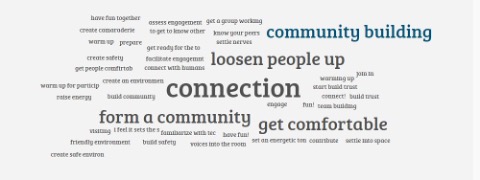Although 2022 did not start the way many of us anticipated or would have liked, it might be comforting to know that as facilitators we have control over how we start sessions or meetings. In a recent FLO Friday session, we explored icebreakers.
Post by Helena Prins and Olaolu Adeleye, advisors, Learning + Teaching, BCcampus
Merriam-Webster Dictionary gives two definitions for icebreaker, and both apply to our context.
ice·break·er
/ˈīsˌbrākər/
Noun
- A ship equipped (as with a reinforced bow) to make and maintain a channel through ice
- Something that is done or said to get through the first difficulties in starting a conversation or discussion
Some icebreakers are light and fun and set a pleasant and inclusive tone to your meeting, such as playing music as participants arrive. Others must be planned with more strategic intention to establish a positive rapport for difficult conversations, such as participating in anonymous brainstorming activities.
Using the word cloud tool AnswerGarden, our participants offered their thoughts about the purpose of icebreakers.
Many reasons exist for starting your session with an icebreaker; the rationale for doing so typically falls within one of the following themes:
- Warming up
- Building rapport
- Establishing community
These purposes align well with the overarching benefits of using icebreakers:
- Community – Finding commonalities as a bridge for further collaboration
- Interaction – Using laughter or dialogue to usher people into a “stretch zone”
- Empathy – Understanding positionality and others’ points of view
One item we discussed was the importance of thinking about potential risks and considerations when you choose an icebreaker. Here are some to keep in mind:
- Sensitivity: Be mindful of the varied perspectives participants may have on a particular topic, and create an environment that honours and respects these differences. Consider whether participants will work together over a longer period or if this is just a once-off.
- Open-ended: Offer an opportunity for participants to give their personal perspectives rather than leading them in a particular direction.
- Low barrier: Make it easy to participate in the icebreaker.
- Technology: Consider the bandwidth, device requirements, and current frame of reference or skillset of your students. If your icebreaker is too technical and complicated, it might not be fun.
- Duration: Keep is short, keep it sweet, and keep it simple.
- Anonymity: Some participants may be concerned about judgement from their peers or sharing personal information in a virtual space. This allows you to catalyze conversation based on participants’ responses without singling out any individual.
If you missed the session and would like to view the recording, you can do so on the event page.
Need some help producing a creative icebreaker? We’ve got you covered! You can find a list of fun and fabulous ideas on this Dotstorming board created by the participants from the session.
The featured image for this post (viewable in the BCcampus News section at the bottom of our homepage) is by James Cheney from Pexels

